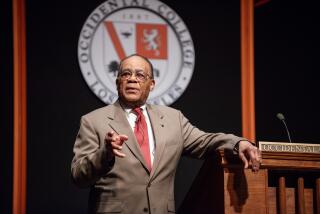Joseph Kaplan; Pioneered in Study of Stratosphere
- Share via
Joseph Kaplan, the eminent physicist with an earthy viewpoint who headed the U.S. National Committee for the International Geophysical Year, died Thursday.
Kaplan, who was a pioneer in the chemistry and physics of the stratosphere and a champion of student athletes on the earthbound playing fields of American universities, was 89 and died in Santa Monica after a heart attack.
In a career that spanned five decades, curiosity took the UCLA professor into aerospace research, geophysics, meteorology and the research of his fellow scientists around the world.
In 1944, he co-founded and became first director of the Institute of Geophysics at the University of California (later the Institute of Geophysics and Planetary Physics), which involves five branches throughout the UC system and has a scientific staff of 120.
Nineteen members of the group have been appointed to the National Academy of Sciences, one has received a Nobel Prize, two were awarded the National Medal of Science and one received Europe’s Balzan Prize.
During World War II, Kaplan was chief of the operations analysis sections of the 2nd Air Force and the Air Weather Service and served as an aerospace adviser to Presidents Dwight D. Eisenhower and Richard M. Nixon. Elected to the National Academy of Sciences in 1957, he was one of three men to receive the Smithsonian Institution’s Hodgkins Medal in 1967. It was the first time the medal had been awarded since 1902.
He had been on the UCLA faculty for 42 years when he retired in 1970. He had served as campus faculty representative, a position that led him to conclude that the late football coach Red Sanders “was as great a teacher as I’ve ever seen in any classroom.”
In that period, Kaplan--who needed only three years to complete both his master’s and doctoral degrees at Johns Hopkins University--moved from being an outspoken opponent of athletics to an advocate of granting degrees in specific sports.
In a 1969 interview with The Times, Kaplan said that at first he wanted to “do away with athletics completely. I didn’t feel that they were a decent thing for a university.”
But he soon came to believe that class credits should be given for the long hours that athletes spend on the fields, courts and diamonds, just as they are granted for classroom and lab work.
“I see no difference in a boy preparing to become a football or basketball player or a boy learning to be a violinist, a social worker or a surgeon,” he said.
In 1928, when he first came to UCLA, he was one of the few scientists in the country concerned with the upper atmosphere. His area of expertise included the aurora borealis, the northern lights that glimmer 100 miles above the Earth.
But in those days, he said, most people had never even seen images of the northern lights.
“Whenever I got up to talk, people would walk out and most of my colleagues said I had no future in science.”
But it was his research that was to make him the winning candidate for the U.S. International Geophysical Year Committee in 1956, a time when the nations of the world tried to put aside their differences to ponder the principles that guide the universe.
One of those principles, he said, he once passed along to a UCLA defensive halfback:
“Never collide with anyone. Just intercept those passes and run out of bounds. That’s elementary physics.”
Kaplan is survived by his wife, Frances.






